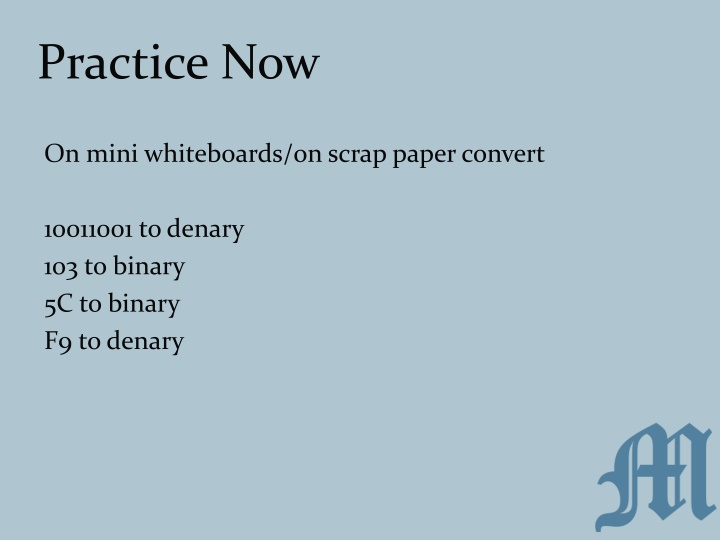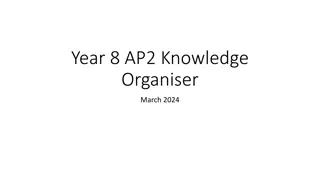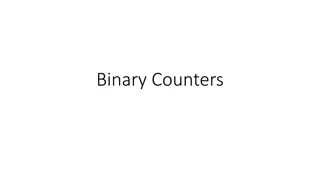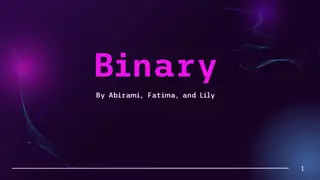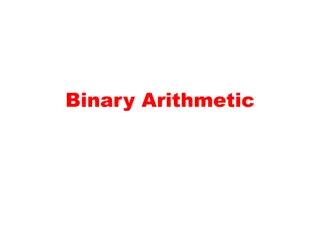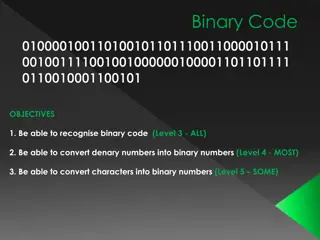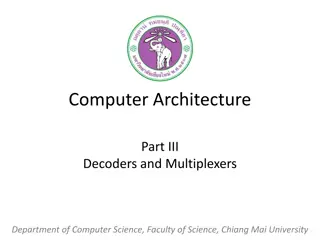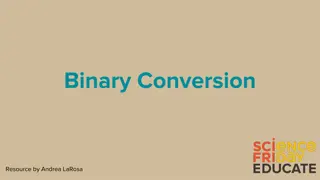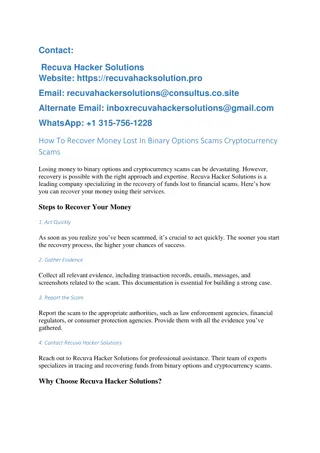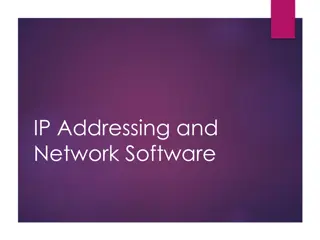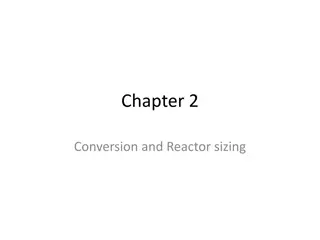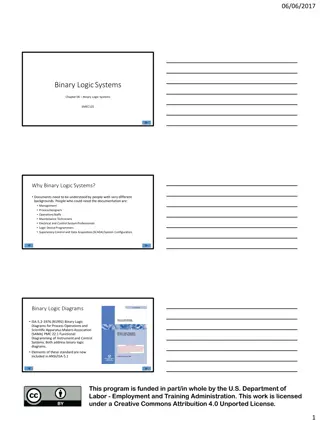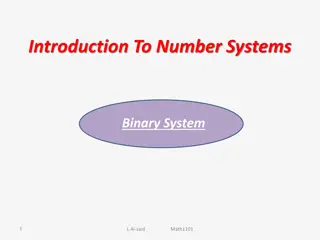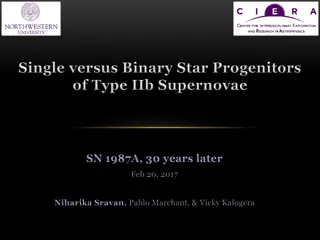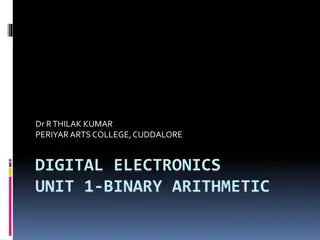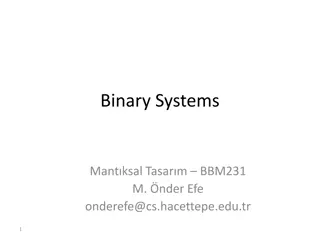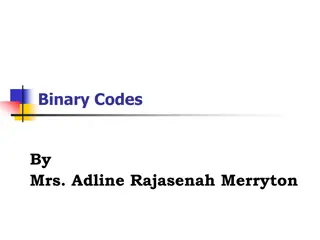Practice Now: Binary & Denary Conversion
Convert binary numbers to denary and vice versa using mini whiteboards or scrap paper. Master converting binary numbers like 10011001 to denary, 103 to binary, 5C to binary, and F9 to denary. Increase your computational skills with these exercises.
Download Presentation

Please find below an Image/Link to download the presentation.
The content on the website is provided AS IS for your information and personal use only. It may not be sold, licensed, or shared on other websites without obtaining consent from the author.If you encounter any issues during the download, it is possible that the publisher has removed the file from their server.
You are allowed to download the files provided on this website for personal or commercial use, subject to the condition that they are used lawfully. All files are the property of their respective owners.
The content on the website is provided AS IS for your information and personal use only. It may not be sold, licensed, or shared on other websites without obtaining consent from the author.
E N D
Presentation Transcript
Practice Now On mini whiteboards/on scrap paper convert 10011001 to denary 103 to binary 5C to binary F9 to denary
Practice Now On mini whiteboards/on scrap paper convert 10011001 to denary 153 103 to binary 01100111 5C to binary 01011100 F9 to denary 249
Lesson Objective: How do we get as much bang for our buck as possible? Success Criteria: I know (and can use) the planning structure for an 8 mark question I know (and can use) the planning structure for an algorithm question
8 Mark Question Structure This is a description of the topic you have been given. Discuss the impact of this topic. You may wish to consider the impact on: Area 1 Area 2 Area 3 Etc
8 Mark Question Structure Area 1 Area 2 Area 3 Area 4 + - Mark Band 3-High Level (6-8 marks) Thorough knowledge and understanding Evidence/examples will be explicitly relevant to the explanation. Weighs up both sides of the discussion and includes reference to the impact on all areas Mark Band 2-Mid Level (3-5 marks) Reasonable knowledge and understanding (although one or two opportunities are missed) Evidence/examples are for the most part relevant to the explanation. There is a reasonable attempt to discuss the impact on most areas
Exam Practice 8 marks Virtual reality is a current trend in Computer Science which is becoming increasingly popular. Discuss the impact of increased use of virtual reality. In your answer you might consider the impact on: Stakeholders Technology Ethical issues Legal issues
Marking Decide the mark band Decide if it just meets the mark band (bottom mark), almost meets the next one (top mark) or neither (middle mark) 1) 2) Mark Band 3-High Level (6-8 marks) Thorough knowledge and understanding Evidence/examples will be explicitly relevant to the explanation. Weighs up both sides of the discussion and includes reference to the impact on all areas Mark Band 2-Mid Level (3-5 marks) Reasonable knowledge and understanding (although one or two opportunities are missed) Evidence/examples are for the most part relevant to the explanation. There is a reasonable attempt to discuss the impact on most areas
Q2d Decide the mark band Decide if it just meets the mark band (bottom mark), almost meets the next one (top mark) or neither (middle mark) 1) 2) Mark Band 3-High Level (6-8 marks) Thorough knowledge and understanding Evidence/examples will be explicitly relevant to the explanation. Weighs up both sides of the discussion and includes reference to the impact on all areas Mark Band 2-Mid Level (3-5 marks) Reasonable knowledge and understanding (although one or two opportunities are missed) Evidence/examples are for the most part relevant to the explanation. There is a reasonable attempt to discuss the impact on most areas
Algorithm Question Structure Define function 1. 2. Define variables/constants 3. Get inputs 4. Write any processes 5. Return any output
Algorithm Question Structure Define function 1. 2. Define variables/constants 3. Get inputs 4. Write any processes 5. Return any output
Exam practice- algorithm Octal Logic Boolean Motherboard Output Input Iteration Write an algorithm for a linear search which will return the location of a target word inputted by the user, or Not found if the target is not in the array. [5]
Marking Target word taken as input Iteration used to visit each index in array Selection used to compare each index with target Output location of target if found Otherwise Not found outputted targetWord = USER INPUT found=False for i = 0 to 7: IF array[i]==targetWord THEN location = i found=True IF found==True THEN OUTPUT targetWord + has been located at index + location ELSE OUTPUT Not found
Lesson Objective: How do we get as much bang for our buck as possible? Success Criteria: I know (and can use) the planning structure for an 8 mark question I know (and can use) the planning structure for an algorithm question
Practice Now On mini whiteboards/on scrap paper convert 11111100 to denary 167 to binary CC to binary 3B to denary
Practice Now On mini whiteboards/on scrap paper convert 11111100 to denary 252 167 to binary CC to binary 3B to denary 1010 0111 1100 1100 59
Lesson Objective: What do we need to know about Systems Architecture? Success Criteria: 1. The purpose of the CPU 2. Von Neumann architecture (including MAR, MDR, PC, ACC) 3. Common CPU components and their function (including ALU, CU, Cache, Bus) 4. The function of the CPU as fetch and execute instructions stored in memory 5. How common characteristics of CPUs affect their performance (including cache size, clock speed and number of cores) 6. Embedded systems (including purpose and examples)
What is the CPU? What does CPU stand for? What is it s main job? How does it do it s job?
What is the CPU? CPU stands for Central Processing Unit it is the processor part of the computer system. Its main job is to process data and instructions It does this by carrying out each part of the Fetch Execute cycle
Cache size Clock speed What is the cache? Why does it exist? What does it contain? What is clock speed? What is it usually measured in? Cores What is a core? What do the following mean? Dual Core Quad Core Single core How do the number of cores affect the speed of the computer?
Clock speed This is how many instructions per second a processor can carry out. Measured in Hertz (Hz) - typical speeds are measured in MHz (million instructions per second) and GHz (billion instructions per second)
Cache size What is the cache? Why does it exist? What does it contain?
Cache size Processors have Cache This is very fast, and usually a very small amount of memory on the processor chip The Cache acts as an in between between the processor and the Main Memory As programs are executing the Cache holds commonly used instructions
Cores What is a core? What do the following mean? Dual Core Quad Core Single core How do the number of cores affect the speed of the computer?
Cores Each processor has a core in which instructions are executed. Processors can be multi-core Dual Core Quad Core 8 Core Each core executes instructions independently Dual Core may execute up to twice as many instructions per second
Von Neumann Architecture Draw the Von Neumann architecture
